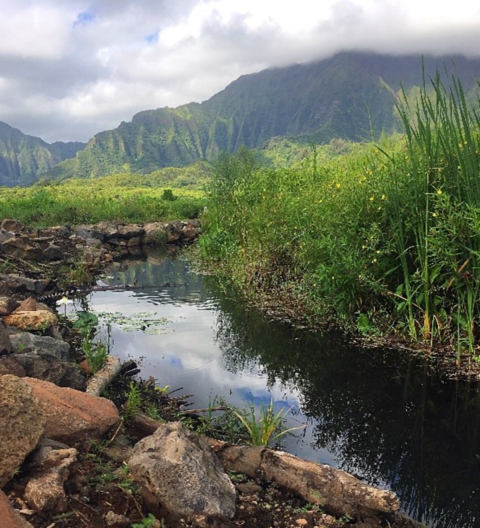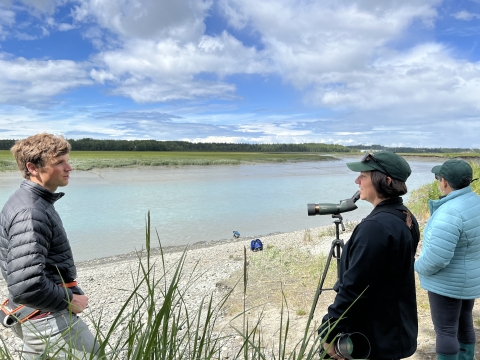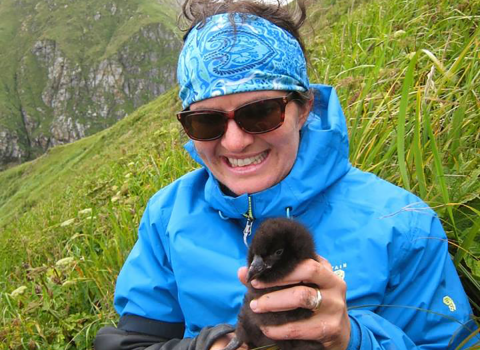Coastal wetlands are among the most productive ecosystems in the world providing resting, feeding, and breeding habitat for waterfowl and other migratory birds, and creating habitat for endangered and threatened species that are dependent on coastal areas. The U.S. contains 75.5 million acres of wetland resources that also provide ecosystem services through drinking water filtration, buffering against storms and flood control, as well as local economic opportunities through outdoor recreation-related expenditures and jobs. Each year the U.S. Fish and Wildlife Service (Service) supports the protection and restoration of these vital wetlands with millions of dollars in grants awarded through The National Coastal Wetlands Conservation Grant Program (NCWCG).
The grant program is co-administered by the Service’s Wildlife and Sport Fish Restoration Program and the Coastal Program. While co-administered by these two programs, many other programs within the Service including the National Wildlife Refuge System and Ecological Services work to conserve wetlands and the species found there. Working together these programs support long-term wetland conservation by awarding funds for wetland conservation projects. The program, funded in part through taxes paid on equipment and fuel purchases by recreational anglers and boaters, creates significant benefits for wildlife as well as recreationists and the American public. Since 1992, the grant program has provided more than $400 million to restore and protect wetlands and associated habitats. Between $18 million and $23 million are available for projects annually to eligible state agencies and their partners including local governments, private landowners, conservation groups, and others. Grant recipients and their partners contribute millions in additional matching funds. The following highlights are just a few examples of NCWCG Program projects that acquire, restore, and enhance coastal wetlands and adjacent upland areas to provide long-term conservation benefits to fish and wildlife and their habitats.
North Fork Siuslaw Tidal Wetlands: The North Fork marsh is a significant estuarine wetland located near Florence, Oregon on the North Fork Siuslaw River. Through NCWCG Program funding 247 acres of formerly diked cattle pasture are being transformed to a functioning ecosystem that will provide habitat for a diversity of terrestrial and aquatic species. A future phase of the project aims to reconnect approximately 236 acres of floodplain to the North Fork Siuslaw River through levee breaching, re‐establishing the historic tidal hydrology, and creating secondary features that promote habitat complexity. Once tidal hydrology is restored and secondary channels reform, the increased habitat complexity will benefit wetland plants and wildlife including coho salmon.
He‘eia Wetlands Restoration: He‘eia is a historically, culturally, and ecologically important watershed on O‘ahu’s eastern coast. The Hawai‘i Department of Land and Natural Resources, Division of Aquatic Resources was awarded NCWCG Program funds to restore a rare freshwater and brackish wetland system to recreate the hydrological and vegetation conditions necessary for native birds and diadromous and estuarine fish to thrive. This restoration of He‘eia’s wetlands is increasing biodiversity by opening up waterways, recreating freshwater ponds and wetland systems and replanting native vegetation to increase the abundance and diversity of native birds, while providing habitat connectivity for Hawai‘i’s unique diadromous fish. Community members are significantly involved in the project, which also includes restoration of traditional Hawaiian cultural practices.
Kasilof River “Dinosaur Parcel” Acquisition: The Alaska Department of Natural Resources, in partnership with the Conservation Fund, was awarded NCWCG Program funds to acquire over 300 acres of pristine habitat along the Kasilof River on the western Kenai Peninsula in southcentral Alaska. The project protects 283 acres of coastal wetland habitat in the Kasilof River Flats that will be added to an existing state park unit for wildlife habitat and compatible public recreation. The property also provides migratory, nesting, and overwintering habitat for 165 bird species such as rock sandpipers and will benefit Chinook, Sockeye, Coho and Pink Salmon and the federally endangered Cook Inlet beluga whale.
San Francisco Bay Wetlands Revegetation: In California, The Coastal Conservancy received NCWCG Program funds to enhance more than 2,000 acres of degraded tidal marsh in the San Francisco Bay. The project includes planting 40,000 native plant seedlings and the treatment of non-native plants to protect previous marsh restoration efforts. The project is working to establish native plants in the tidal marsh and adjacent habitat to provide food and nesting, breeding and high tide refuge habitat for the federally protected California Ridgway’s rail and other tidal-marsh dependent wildlife such as the endangered salt marsh salt marsh
Salt marshes are found in tidal areas near the coast, where freshwater mixes with saltwater.
Learn more about salt marsh harvest mouse, California least tern, and state-listed California black rail.
Point Au Sable Nature Preserve/Wequiock Creek Coastal Wetlands: The Wisconsin Department of Natural Resources, in partnership with the Northeast Wisconsin Land Trust and the University of Wisconsin-Green Bay, used NCWCG Program funds to acquire 73.8 acres of land along Wequiock Creek and to restore 25 acres of emergent wetlands on the adjacent Point au Sable Nature Preserve in Brown County, Wisconsin. This area attracts more than 220 species of migratory birds, including bald eagles. The area also provides habitat for fish, amphibians, bats, mammals, and invertebrates. The project will also provide opportunities for fish and wildlife-based recreation, public use and enjoyment of natural resources, and will expand educational and research opportunities at the Point au Sable Nature Preserve.
Shellbine Acquisition: The Georgia Department of Natural Resources is using NCWCG Program funding to protect approximately 1,899 acres of diverse habitat known as the Shellbine Tract in Glynn County Georgia. The area includes tidal wetlands and adjacent uplands in the lower Satilla River watershed. More than 100 rare plants and animals occur at the site. The tract is part of a larger project by the state, The Nature Conservancy, Open Space Institute, and U.S. Department of Defense to conserve an 11,000-acre area and connect 1.5 million acres of conservation lands in the Coastal Georgia Ecoregion, including Okefenokee National Wildlife Refuge and the Altamaha River Corridor, and increase recreational access to coastal waters.








